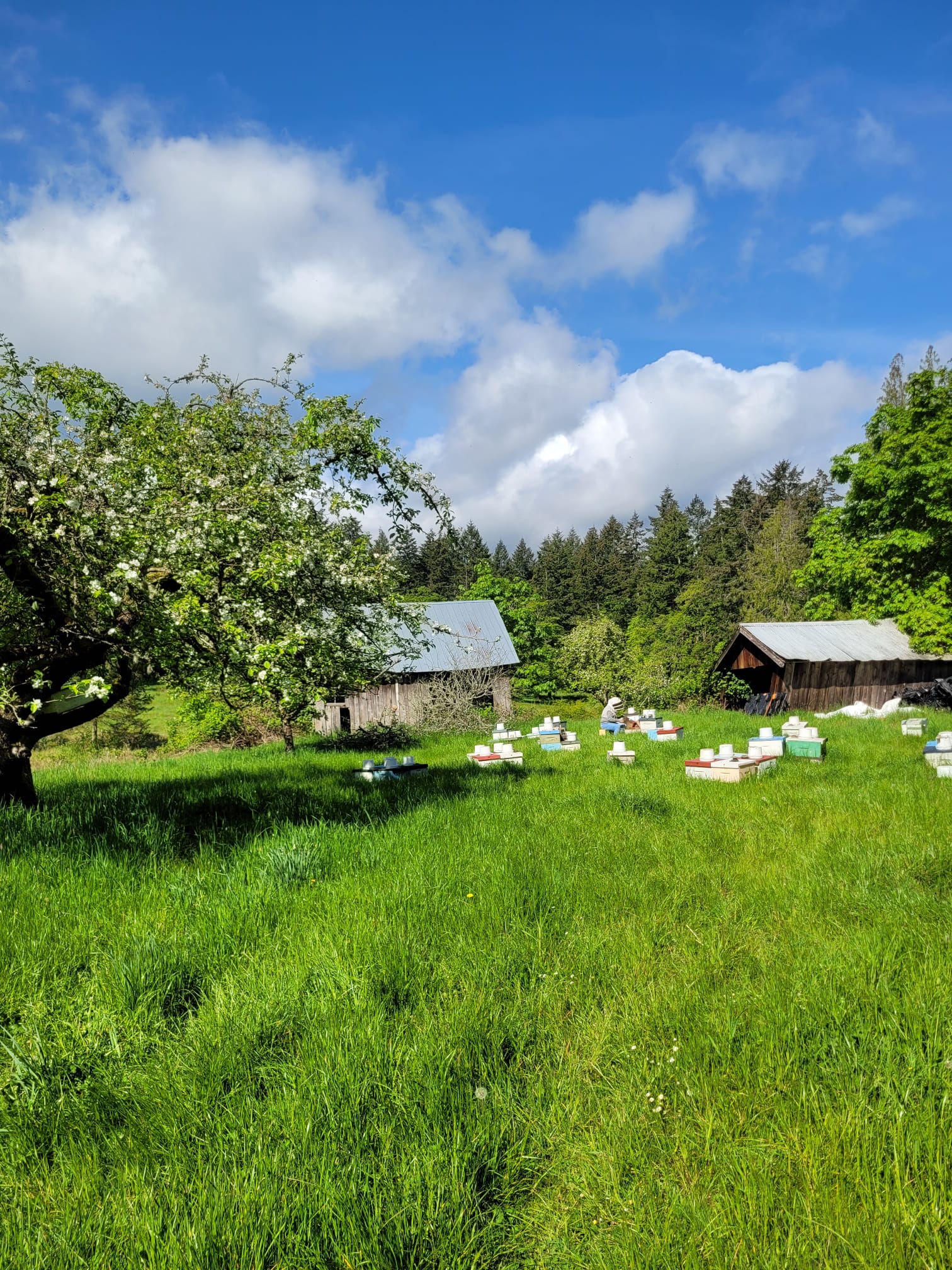· By Angela Seto
Our California queens are taking over

An idyllic moment on the bee yard.
What's new on the farm:
It's been a few weeks since our last farm update, and I'm happy to say that things are looking good!
Our packages from New Zealand have been booming since we received them in March.
We have been getting beautiful sunshine and tons of blooms from the flowers and trees.
First, we had the maple bloom, which was beneficial to kick-start their growth. They were bringing in so much nectar that you could taste the maple honey in the combs.
Arbutus is our current main bloom, and soon the hawthorns and ground clovers will start to open up.
The hives have so much pollen that the queens are starting to run out of room to lay their eggs. This is a blessing and a curse! A blessing because the hives are enjoying a bounty of food, but a curse because if you don't stay on top of it and give the hives enough room, they will get plugged up with food. Then the queen won't be able to keep laying eggs, and growth will slow down.
That means we are spending a lot of time adding more space to the hives.
Requeening the hives
Another job we have to do is replace our New Zealand queens with new queens we brought in from California.
We had our first batch of queens arrive this past Thursday and introduced them into the hives the same day.
Why are we replacing the New Zealand queens? As you might know, Canada and New Zealand have a lot of differences, including climate.
We learned the hard way that the genetics of New Zealand queens are not suitable for beekeeping where we are in Canada. The bees are a great source for starting hives, but aren't great at surviving. And we want to have hives that will be able to last season after season.
There are many different subspecies of the Western honey bee (Apis mellifera). The honeybees we brought in from New Zealand are actually a subspecies called Apis mellifera ligustica (or "Italian" honey bee).
These bees are suitable for early spring build up, but when it comes to winter, their populations can be too large. As a result, they consume too many resources and can go through honey stores too quickly over the winter.
Additionally, New Zealand is an isolated climate. The bees that are raised and bred there over many generations aren't exposed to many diseases that we face in North America. So when they get here, they are more susceptible to diseases, since they've never faced them before.
Usually, we requeen hives with our own stock of "Saskatchewan" bees. These are mutts that we cross breed from overwintered hives each spring. We know that the surviving hives are hardy and can do well in our environment.
In fact, last week I also did a small graft (a technique to make our own queens) from our hives that survived winter. By the end of this week, we will have new queens hatching. But we also like to introduce genetics from other places so that we can get more diversity in our bees.
This year we are trying out queens from a reputable breeder in California. The subspecies of bees that they breed are called Apis mellifera carnica (or "Carniolan" bees).
Carniolan bees originate from Northern Europe. They have smaller winter populations and are more efficient with resources. They also do better in colder weather, and are more responsive to spring weather. That means when spring hits and the flowers and trees begin to bloom, the hives work harder and grow faster.
These are qualities that match with our environment much better. We're excited to see what they are like. We have found that each type of bee has their own "personality."
New Zealand bees are calm and gentle. We have had another subspecies called "Carpathian" bees from Ukraine that are tough but also mean and eager to sting you. Our overwintered mutts are usually pretty aggressive as well. We find that the meaner the bees, the better they tend to survive for us. It will be interesting to see what personality the Californian Carniolans will present!

Whipped ricotta toast with honey:
Mother's Day is coming up next weekend and that might mean a special brunch to celebrate the moms in your life!
If you are putting together a menu, whipped ricotta toast with honey is a tasty and fancy addition that is simple to prepare.
You can make it savory with marinated tomatoes and olive oil, or sweet and bright with some fresh berries.
Check out the recipe at Half Baked Harvest to try it out!
